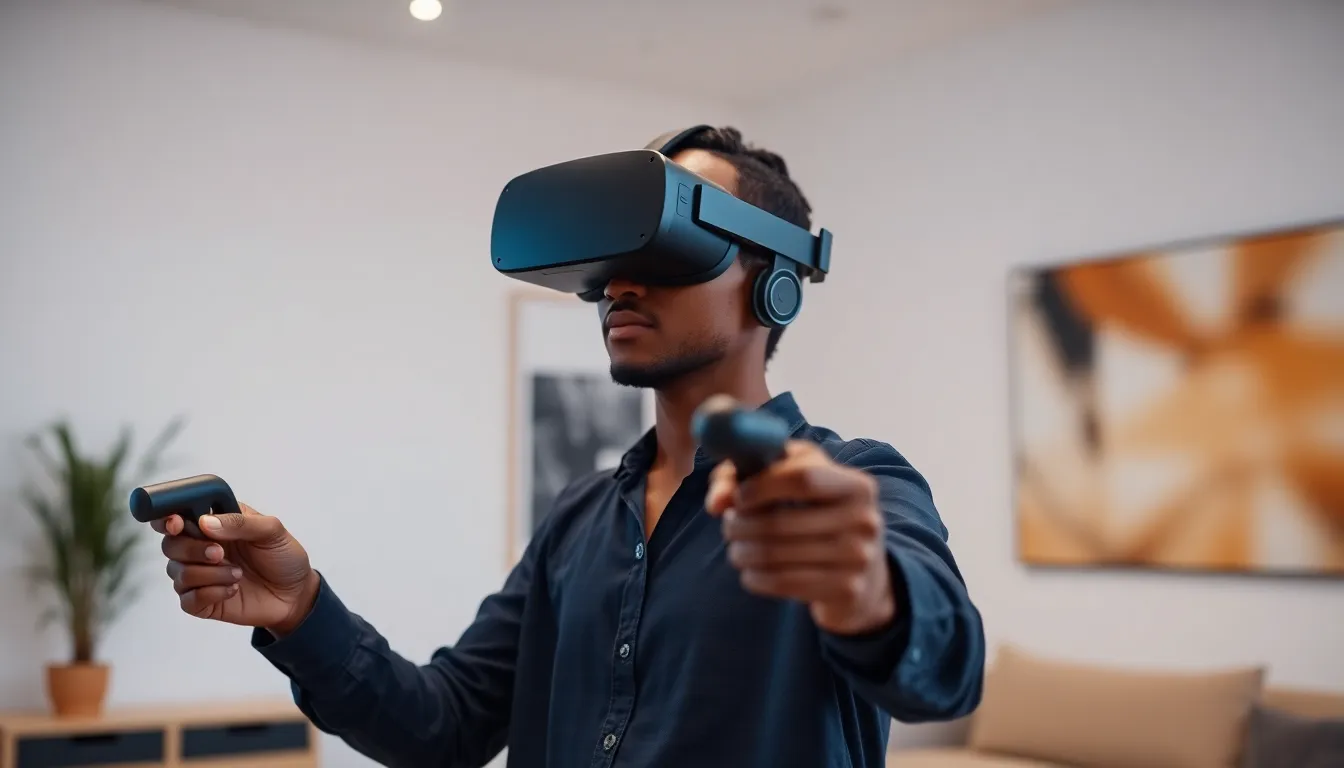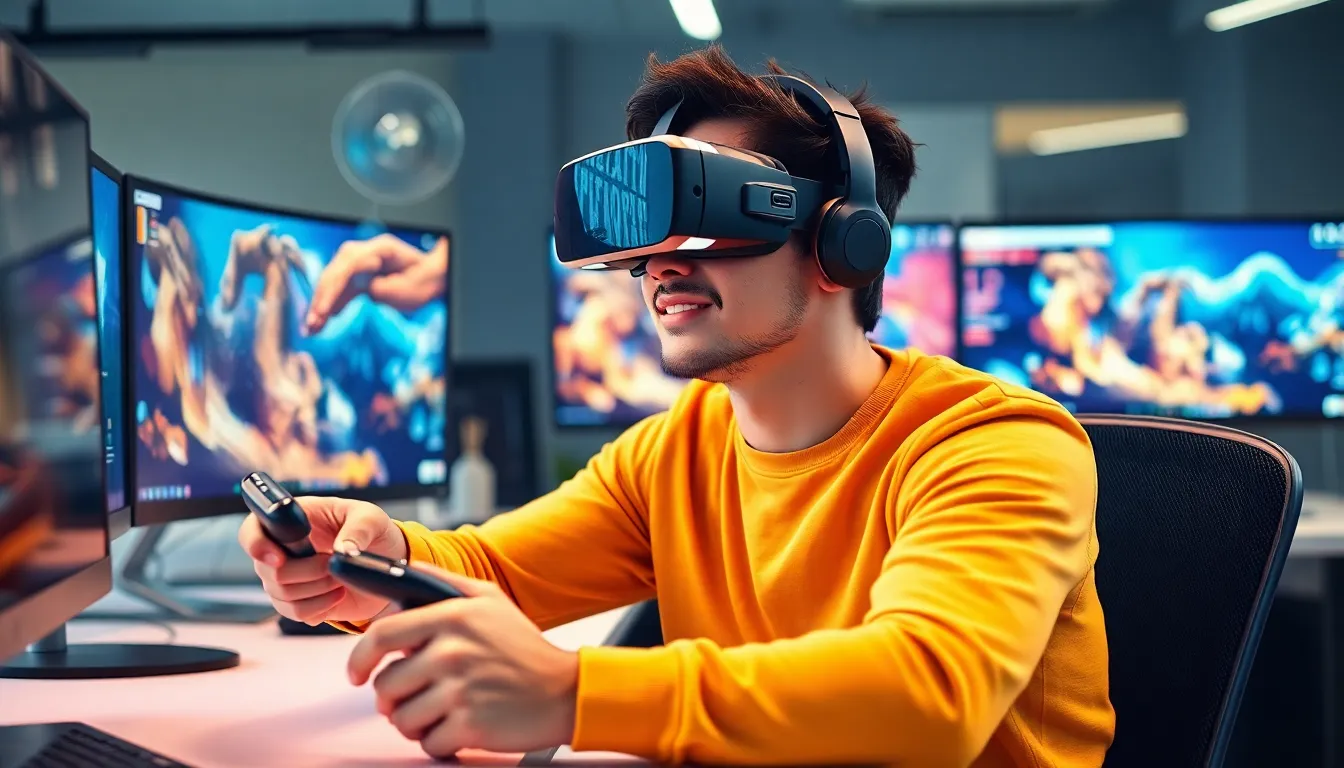Table of Contents
ToggleImagine slipping on a headset and suddenly finding yourself in a world where the laws of physics are mere suggestions. Virtual reality development isn’t just about creating games; it’s about crafting immersive experiences that transport users to fantastical realms or even back in time. Whether it’s battling dragons or exploring the depths of the ocean, VR is revolutionizing how we interact with digital content.
But let’s face it—developing for VR can feel like trying to teach a cat to fetch. It’s complex, challenging, and sometimes downright bizarre. Yet, the potential rewards are massive. As technology advances, developers have the unique opportunity to shape the future of entertainment, education, and beyond. Dive into the exciting world of virtual reality development, where creativity meets innovation, and the only limit is your imagination.
Overview of Virtual Reality Development
Virtual reality development entails creating immersive digital environments that mimic real-world experiences. Significant advancements in technology enhance developers’ ability to craft detailed visuals and interactive elements. Many industries now leverage VR, including entertainment, healthcare, and education, showcasing its versatility.
Tools and software play a critical role in the development process. Popular platforms such as Unity and Unreal Engine enable developers to build VR applications efficiently. Familiarity with programming languages like C# or C++ is often essential, as scripts govern interactions within the virtual space.
User experience design remains a vital factor. Developers must prioritize user comfort and engagement, ensuring intuitive navigation and interaction. Testing plays a key role in revealing areas for improvement, validating design choices, and ensuring a seamless experience. Incorporating user feedback fosters a refined product tailored to audience preferences.
Challenges characterize the VR development landscape. Hardware limitations can restrict performance and accessibility, as high-quality visuals demand powerful devices. Additionally, developers confront the need to optimize applications for various platforms, such as Oculus Rift, HTC Vive, and PlayStation VR.
Monetization strategies also influence development decisions. As the market expands, developers explore diverse revenue streams, including game sales, in-app purchases, and subscription models. Addressing these elements proactively enhances a project’s chances of success in the competitive VR industry.
Innovative possibilities continue to emerge as technology evolves. Virtual reality development represents a frontier filled with transformative potential, offering exciting opportunities for creative expression and impactful applications across multiple sectors.
Key Technologies in Virtual Reality Development

Virtual reality development relies on a blend of state-of-the-art hardware and advanced software platforms to create immersive experiences.
Hardware Components
Hardware components include headsets, sensors, and controllers that enable users to interact with virtual environments. Headsets like Oculus Quest 2 and HTC Vive offer high-resolution displays, providing stunning visuals. Sensors track user movements, enhancing the sense of presence. Controllers provide haptic feedback, allowing for realistic interactions within virtual spaces. Cameras equipped with inside-out tracking further improve user experience by monitoring the environment. Together, these elements form the backbone of effective VR setups, critical for delivering engaging content.
Software Platforms
Software platforms play a key role in building virtual reality experiences, with Unity and Unreal Engine being the most popular choices among developers. Unity offers a user-friendly interface and extensive libraries, making it accessible for newcomers. Unreal Engine boasts high-fidelity graphics and advanced rendering capabilities, appealing to professionals aiming for realism. Both platforms support VR integrations, enabling seamless development across multiple devices. Programming languages like C# and C++ enhance functionality, allowing developers to create intricate interactions. These platforms significantly streamline the development process and influence overall user experience.
The Development Process
The development process of virtual reality includes several critical phases that contribute to creating immersive experiences. Each stage plays a pivotal role in transforming ideas into functional VR applications.
Conceptualizing Ideas
Developers begin by brainstorming innovative concepts tailored to specific audiences. Identifying the target user and their needs streamlines the creative process. Researching current trends also informs developers about what resonates with potential users. Gathering feedback from early discussions helps refine ideas. Prioritization of originality and feasibility shapes the development direction, fostering unique virtual scenarios.
Designing Experiences
User experience design stands at the forefront of creating engaging VR environments. Prioritizing intuitive navigation enhances user interaction with virtual components. Developers must consider comfort factors such as motion sickness and accessibility options. Integrating audio and visual elements strengthens immersion, creating cohesive atmospheres. Utilizing tools like Unity and Unreal Engine aids in designing interactive features and detailed visuals. Prototyping allows for rapid iterations, crafting user-focused experiences that captivate audiences.
Testing and Iteration
Testing serves as a crucial phase for validation and refinement. Developers conduct playtests to uncover usability issues and gauge user reactions. Iterative feedback loops offer insights into necessary adjustments and improvements. Engaging with real users reveals insights that internal teams might overlook. Rigorous testing on various hardware platforms ensures optimal performance and accessibility. Adapting to these findings drives refinements, resulting in a polished final product.
Applications of Virtual Reality Development
Virtual reality development finds applications across various sectors, enhancing user experiences and offering innovative solutions. Key areas include gaming and entertainment, education and training, and healthcare and therapy.
Gaming and Entertainment
Gaming thrives on virtual reality technology, delivering immersive experiences that captivate players. Gamers enjoy realistic environments that enhance engagement and interaction. Popular games like “Beat Saber” and “Half-Life: Alyx” showcase the medium’s potential, providing unique challenges and narratives. The entertainment industry also leverages VR for virtual concerts and interactive experiences, allowing users to connect with content in novel ways. New VR titles consistently emerge, pushing the boundaries of creativity and user engagement.
Education and Training
Virtual reality transforms education and training by creating immersive learning environments. Students engage in subjects like history and science through interactive simulations that enhance retention. In vocational training, VR enables safe practice in scenarios like surgery or machinery operation, lowering risks linked to real-world environments. Educational institutions and corporations realize the cost-effectiveness of virtual solutions, reducing travel and resource expenses while improving learning outcomes. Initiatives in this arena continue expanding, reflecting a growing acceptance of technological advancements in education.
Healthcare and Therapy
Healthcare professionals utilize virtual reality for various therapeutic applications, improving patient outcomes. Tools like VR therapy assist in treating conditions such as PTSD and phobias by creating controlled environments for exposure therapy. Rehabilitation programs focus on physical and cognitive exercises tailored to individual needs, promoting recovery. Surgeons train in simulations that enhance skills without endangering real patients. As VR technology advances, the healthcare sector increasingly embraces these innovative therapies, providing comprehensive support for both patients and practitioners.
Challenges in Virtual Reality Development
Virtual reality development presents various challenges that developers tackle throughout the process. Significant among these challenges are technical limitations that impact performance and user accessibility.
Technical Limitations
Hardware constraints regularly pose challenges in VR development. The need for high-performance components like graphics cards and processors influences developers’ choices. Limited processing power can hinder the quality of graphics and interactions, resulting in subpar experiences. Additionally, compatibility issues arise from the vast range of VR platforms, creating extra hurdles. Developers often optimize applications for devices such as Oculus Rift and PlayStation VR while navigating disparities in hardware capabilities. The challenge lies in balancing performance with visual fidelity, ensuring every user benefits from immersive experiences.
User Experience Issues
User experience issues often emerge during the development phases. Prioritizing user comfort becomes crucial, as motion sickness can occur with poorly designed interactions. Developers continuously seek ways to enhance navigation intuitiveness and minimize discomfort, focusing on smooth transitions and responsive controls. Testing plays an integral role, revealing user preferences and pain points. Feedback informs refinements, driving improvements that contribute to overall satisfaction. Engaging users with varying levels of VR experience requires developers to adapt designs, ensuring that both newcomers and seasoned users feel at ease.
Future Trends in Virtual Reality Development
Advancements in artificial intelligence (AI) are set to revolutionize VR development. AI-powered tools can enhance user interactions through adaptive experiences that respond to behavior in real-time. Automation in content creation facilitates the development process, allowing developers to generate environments and assets more efficiently.
Increased focus on social experiences emphasizes multiplayer functionalities within VR. Social VR platforms promote collaboration and communication, enabling users to interact in shared virtual spaces. Developers invest in creating these experiences to foster community engagement.
Mobile VR technologies continue to gain traction. Devices like the Oculus Quest 2 allow users greater accessibility without the need for external hardware. The demand for portable experiences drives developers to optimize applications for mobile platforms, maintaining high performance across various devices.
Cross-platform compatibility remains a priority. Ensuring seamless experiences across headsets like HTC Vive and PlayStation VR requires attention to user interface design. Developers adapt their applications to provide consistency regardless of the hardware used.
In healthcare, VR applications are expected to expand even more. Therapeutic simulations gain recognition for their effectiveness in mental health treatment, including anxiety and PTSD. As more healthcare providers recognize these benefits, funding for VR solutions is likely to increase.
Sustainability in development practices is another emerging trend. Environmentally conscious developers seek to minimize energy consumption during design and deployment. This shift toward sustainability can attract a broader audience, particularly in industries prioritizing eco-friendly solutions.
Emerging trends signal a bright future for virtual reality development. Collaboration within the industry encourages innovation, leading to richer, more immersive experiences. Staying informed about these trends is crucial for developers aiming to stay competitive in the fast-evolving field of VR.
The future of virtual reality development is filled with exciting possibilities. As technology advances and new tools emerge developers are poised to create even more immersive experiences. The integration of AI and the focus on social interactions will likely reshape how users engage with VR.
Addressing challenges like hardware limitations and user comfort remains crucial for developers. By prioritizing user experience and embracing innovations in the field they can ensure that VR continues to captivate audiences across various sectors.
With a commitment to sustainability and cross-platform compatibility the landscape of VR is set to evolve dramatically. Staying informed about these trends will empower developers to thrive in this dynamic environment.




